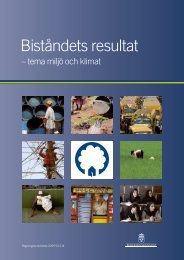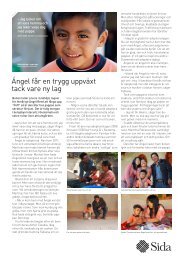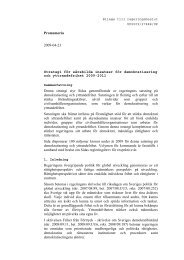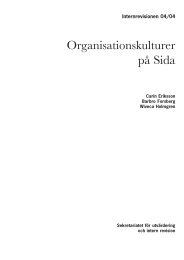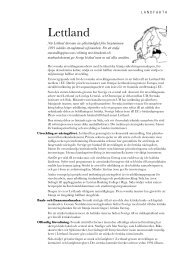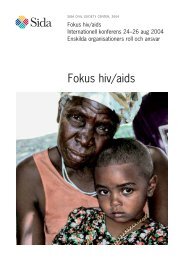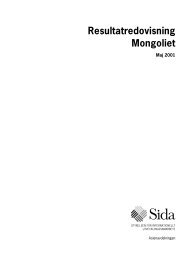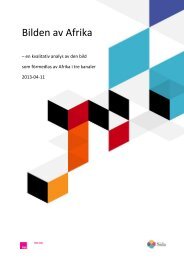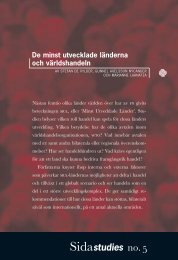Mobilisation of the Poor – a means to Poverty Reduction? - Sida
Mobilisation of the Poor – a means to Poverty Reduction? - Sida
Mobilisation of the Poor – a means to Poverty Reduction? - Sida
Create successful ePaper yourself
Turn your PDF publications into a flip-book with our unique Google optimized e-Paper software.
Relevance<br />
In keeping with <strong>the</strong> TOR for this evaluation we examine below <strong>the</strong> relevance <strong>of</strong> <strong>the</strong> CAP approach<br />
for <strong>the</strong> needs <strong>of</strong> <strong>the</strong> target population, GoSL policies and programmes, and <strong>Sida</strong>’s Action<br />
Programmes.<br />
Relevance <strong>of</strong> CAP approach <strong>to</strong> <strong>the</strong> situation <strong>of</strong> target population<br />
CAP’s emphasis on self-reliance as a key <strong>to</strong> escaping poverty remains highly relevant in a polity<br />
where competitive populism by <strong>the</strong> two major political parties has encouraged <strong>the</strong> growth <strong>of</strong> a<br />
substantial welfare state along with a high level <strong>of</strong> dependency among <strong>the</strong> poor. At present, most<br />
Sri Lankans look on <strong>the</strong> government as <strong>the</strong> main provider <strong>of</strong> opportunities, goods, and services and<br />
many observers note that government policies have worked against a spirit <strong>of</strong> self-reliance, blunted<br />
self-motivation, and stifled innovation and independence (Silva et al. 1996, Silva 1998, Silva et al.<br />
1999, World Bank 1996). Therefore, a development approach such as CAP, that attempts <strong>to</strong> wean<br />
<strong>the</strong> poor from excessive reliance on <strong>the</strong> state and motivate <strong>the</strong>m <strong>to</strong> take charge <strong>of</strong> <strong>the</strong>ir own<br />
development path, is unique among all o<strong>the</strong>r government and <strong>the</strong> majority <strong>of</strong> NGO programmes<br />
that aim <strong>to</strong> reduce poverty.<br />
At one level CAP merely involves a catalytic intervention by an external agent with a view <strong>to</strong><br />
raising <strong>the</strong> awareness <strong>of</strong> people in poverty about <strong>the</strong>ir situation and about possible <strong>means</strong> <strong>to</strong><br />
overcome it in which <strong>the</strong> poor <strong>the</strong>mselves are expected <strong>to</strong> participate collectively. Although this<br />
social probing need not lead <strong>to</strong> one explanation <strong>of</strong> poverty and one single way <strong>of</strong> addressing it (if<br />
that is <strong>the</strong> case <strong>the</strong>re is no need for any specific probing as such), in its formative period, in part<br />
because <strong>of</strong> <strong>the</strong> predominant intellectual paradigms at <strong>the</strong> time, <strong>the</strong> CAP approach became<br />
identified with a production relations approach in which poverty came <strong>to</strong> be unders<strong>to</strong>od primarily<br />
in terms <strong>of</strong> <strong>the</strong> unequal bargaining power <strong>of</strong> small producers compared <strong>to</strong> <strong>the</strong> economic<br />
intermediaries immediately above <strong>the</strong>m. This image <strong>of</strong> poverty was a limited one, even when<br />
applied <strong>to</strong> <strong>the</strong> village situation in rural Sri Lanka at <strong>the</strong> time. It certainly is no longer applicable <strong>to</strong><br />
rural Sri Lanka after nearly 25 years <strong>of</strong> economic liberalisation programmes, devastation, and<br />
socio-economic disruption caused by <strong>the</strong> ongoing armed conflict and by <strong>the</strong> growing openness and<br />
marked tendency on <strong>the</strong> part <strong>of</strong> most Sri Lankans, including <strong>the</strong> poor <strong>the</strong>mselves, <strong>to</strong> evade<br />
ideological minefields.<br />
In response <strong>to</strong> <strong>the</strong> changes noted, CAP itself became less dogmatic over <strong>the</strong> years. Awarenessraising<br />
and group-building efforts have continued, although partly in a mechanical fashion, with <strong>the</strong><br />
building <strong>of</strong> group funds among <strong>the</strong> poor, supplemented by interventions designed <strong>to</strong> promote<br />
income-generating activities increasingly identified and pursued as <strong>the</strong> main path <strong>to</strong> escape poverty.<br />
The limitations <strong>of</strong> this approach as a poverty alleviation strategy are well documented and well<br />
known by now (Lakshman 1994, Silva and Gunatilaka 2000, Gunatilaka 2000, Gunatilaka and<br />
Salih 1999, Gunatilaka et al. 1997) and we need not review <strong>the</strong>m in <strong>the</strong> present report. What needs<br />
<strong>to</strong> be emphasised here is that <strong>the</strong> social probing <strong>–</strong> which is supposed <strong>to</strong> be carried out by <strong>the</strong> poor<br />
in consultation with <strong>the</strong>ir change agents <strong>–</strong> must be broadened <strong>to</strong> include <strong>the</strong>se ongoing concerns,<br />
some <strong>of</strong> which stem from <strong>the</strong> globalisation processes in which <strong>the</strong>y are currently embedded, so that<br />
<strong>the</strong>y can work <strong>to</strong>wards a more comprehensive approach that is at <strong>the</strong> same time more responsive <strong>to</strong><br />
<strong>the</strong> specifics <strong>of</strong> local situations.<br />
Without a CAP-type intervention <strong>the</strong> poor will have <strong>to</strong> fend for <strong>the</strong>mselves as individuals, expecting<br />
ei<strong>the</strong>r trickle-down benefits from a high-growth scenario or <strong>to</strong> escape poverty through <strong>the</strong>ir own<br />
efforts, assisted <strong>of</strong> course by any safety nets or income transfers currently in place. It does not<br />
provide for agency or capacity <strong>of</strong> <strong>the</strong> poor <strong>to</strong> collectively influence <strong>the</strong> shape <strong>of</strong> things <strong>to</strong> come. It<br />
44<br />
MOBILISATION OF THE POOR <strong>–</strong> A MEANS TO POVERTY REDUCTION <strong>–</strong> <strong>Sida</strong> EVALUATION 02/08




